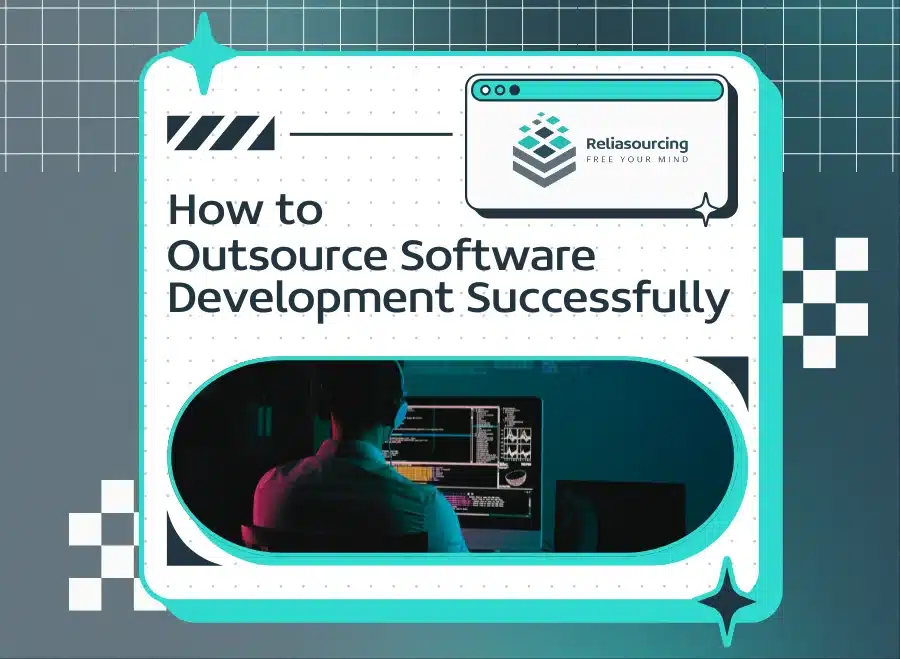Outsourcing software development is a strategic approach in which businesses assign software projects to external teams rather than depending solely on in-house developers. Adopting such a strategy enables companies to lower costs and access specialized skills to scale operations efficiently.
Many businesses choose outsourcing because it offers significant cost savings, eliminates the expenses of hiring and maintaining full-time employees, and provides access to a diverse talent pool with niche technical skills. Additionally, outsourcing enables faster project delivery, as external teams dedicated to specific tasks can streamline development timelines.
The industries that benefit the most from outsourcing include FinTech, which relies on secure and scalable financial applications; Software-as-a-Service (SaaS) companies, which require continuous cloud-based software development; e-commerce businesses, which need custom platforms and integrations to enhance the customer experience; and the gaming and entertainment sector, which demands high-performance applications and specialized development expertise.
What is Software Development Outsourcing?
Software development outsourcing refers to hiring external teams or companies to handle software development projects instead of relying on in-house developers. Businesses opt for outsourcing to access specialized talent, reduce costs, and scale efficiently without the overhead of an internal development team since outsourcing differs from in-house development in several ways:
- Cost structure. No need to maintain full-time employees, reducing salary and operational expenses.
- Talent pool. Access to a global talent network with specialized expertise.
- Scalability. Quickly scale teams up or down based on project needs.
The Benefits of Outsourcing Software Development
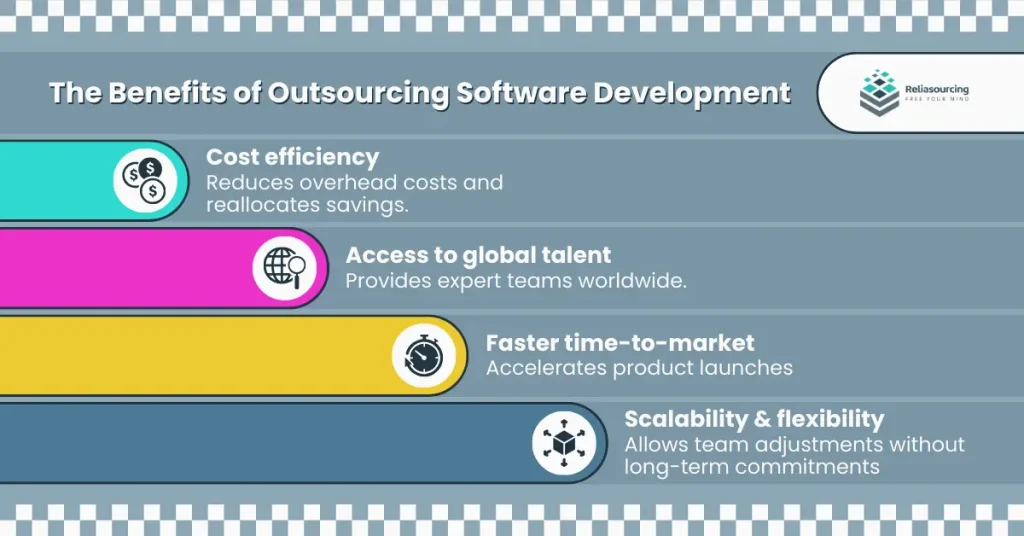
- Cost efficiency. Hiring offshore developers, especially in regions like the Philippines, can be significantly more affordable than maintaining an in-house team. Outsourcing allows businesses to avoid overhead costs such as office space, employee benefits, and long-term salary commitments. As a result, companies can allocate these cost savings to other critical business operations such as marketing or customer acquisition.
- Access to global talent. Outsourcing firms provide access to skilled developers with expertise in various technologies and frameworks. Instead of being limited to local talent, businesses can work with specialized teams worldwide to find the proper skill set for their projects.
- Faster time-to-market. Efficient teams reduce development cycles and accelerate product launches, crucial for startups and tech firms in competitive markets. Being the first to launch can significantly impact market share.
- Scalability & flexibility. Businesses can adjust their development teams according to project needs without long-term commitments. Such flexibility enables efficient management of peak workloads without employing permanent staff who may not be necessary after project completion.
Challenges & Risks of Outsourcing (and How to Overcome Them)
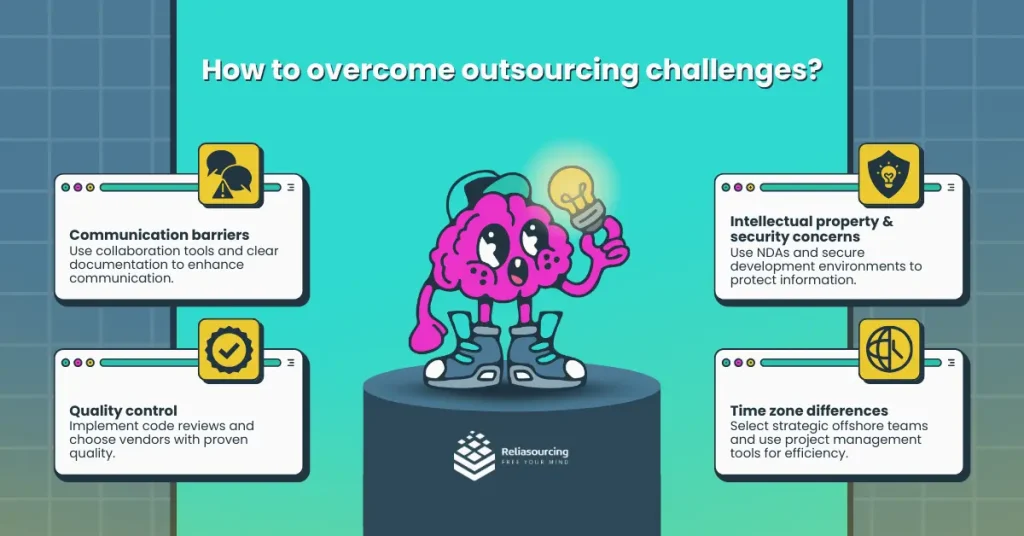
- Communication barriers. A significant obstacle to outsourcing is the chance of miscommunication, mainly when working with teams from various cultural and linguistic backgrounds. To mitigate this issue, companies should establish clear documentation, leverage collaboration tools like Slack or Microsoft Teams, and define expectations early on. Consistent video meetings and comprehensive reports can also promote transparency.
- Quality control. Some businesses worry that outsourced teams may not meet their quality standards. The best way to address this concern is to work with vendors with proven track records that attest to their quality assurance processes and strong portfolios. Additionally, implementing code reviews and regular testing throughout the development cycle can help maintain high standards.
- Intellectual property & security concerns. Businesses must protect sensitive information when outsourcing software development. To safeguard proprietary data, companies should use legal agreements, Non-Disclosure Agreements (NDAs), and secure development environments. Selecting a vendor with robust cybersecurity protocols and complies with industry-standard certifications is essential.
- Time zone differences. Managing teams across different time zones can lead to workflow inefficiencies. To address this challenge, businesses can choose nearshore or strategically located offshore teams, allowing overlapping work hours. Additionally, leveraging project management tools like Jira and Trello can streamline collaboration and task tracking.
How AI is Changing Software Development Outsourcing
Artificial Intelligence (AI) is revolutionizing outsourcing through automation, predictive analytics, intelligent coding tools, and AI-driven project management. AI-powered tools can automate repetitive coding tasks, analyze large datasets to predict development challenges and enhance software testing efficiency. Machine learning algorithms likewise improve project estimation accuracy and help businesses make data-driven decisions.
With AI Outsourcing, chatbots and virtual assistants play a crucial role in project management by streamlining communication, tracking progress, and reducing human errors. By leveraging AI-driven analytics, businesses are equipped to optimize workflows, improve risk management, and ensure code quality by detecting vulnerabilities before they become critical.
As AI evolves, businesses will begin to explore integrating AI-driven automation into their outsourcing strategies. AI now holds the potential to boost efficiency and increase the success rates of outsourced software development projects, ranging from intelligent debugging tools to automated quality assurance systems.
Software Development Outsourcing Models
Outsourcing comes in multiple forms, each offering unique advantages and drawbacks. Companies in various industries rely on outsourcing to scale efficiently, reduce operational costs, and enhance development capabilities.
Pros
- Easier communication due to the same language and culture.
- No significant time zone differences, leading to smoother collaboration.
- Stronger legal protections and compliance with local regulations.
Cons
- Significantly higher costs compared to offshore options.
- Limited access to specialized global talent.
- Smaller talent pool, leading to potential hiring challenges.
Nearshore Outsourcing
Pros
- Lower costs compared to onshore outsourcing while maintaining real-time collaboration.
- More accessible travel options for on-site visits and team meetings.
- Fewer language barriers and better cultural alignment than offshore outsourcing.
Cons
- Can still be more expensive than offshore outsourcing.
- Talent availability depends on the region, which may limit expertise.
- Possible regulatory and compliance differences between countries.
Offshore Outsourcing
Pros
- Substantial cost savings, often reducing expenses by more than 50%.
- Offshore Outsourcing gives access to a vast global talent pool with specialized expertise.
- 24/7 development cycle due to time zone differences, accelerating project timelines.
Cons
- Potential communication barriers due to language and cultural differences.
- More challenging project management requires structured workflows and tools.
- Intellectual property and data security concerns that need legal safeguards.
How to Choose the Right Software Outsourcing Partner

Selecting the right outsourcing partner is critical to project success. A well-vetted vendor helps ensure quality, streamline collaboration, and protect your business interests. Here’s a detailed breakdown of what businesses should consider:
1. Evaluate expertise & experience
Examine potential vendors’ portfolios, past projects, and industry experience to confirm their technical capabilities match project requirements. Look for vendors with case studies demonstrating their success in handling projects similar to yours. Consider asking for references from previous clients to gauge their experience working with the vendor.
2. Assess technology stack & specialization
Not all outsourcing partners excel in every technology. Identifying vendors with a strong understanding of the programming languages, frameworks, and development methodologies your project needs is necessary, as doing so will ensure they can deliver high-quality work without an extensive learning curve.
3. Check communication & workflow processes
Smooth collaboration hinges on clear communication. Confirm that the vendor uses agile methodologies, structured reporting systems, and reliable communication tools like Slack, Microsoft Teams, or Jira. Establish a dedicated point of contact to ensure consistent and timely updates. Additionally, request regular sprint reports and progress meetings to track milestones.
4. Understand cost structures
Transparency in pricing is key to avoiding hidden costs. Request detailed breakdowns of pricing models, whether fixed cost, time-and-material, or milestone-based billing. Consider vendors that offer scalable engagement models to adjust resources as needed without incurring unnecessary expenses.
5. Review client testimonials & case studies
A vendor’s reputation speaks volumes about its reliability. Browse customer testimonials on platforms like Clutch, GoodFirms, and Google Reviews. Look for vendors with high ratings, detailed case studies, and long-term client relationships, which indicate trustworthiness and consistent service quality.
6. Clarify security & IP protection
Protecting your intellectual property and sensitive data should be a priority. Ensure contracts include robust data security policies, NDAs, and compliance with international security standards such as ISO 27001 and GDPR. Vendors should likewise offer secure development environments, version control best practices, and encrypted data storage to prevent breaches.
7. Assess scalability & long-term compatibility
Choose a partner capable of scaling up or down based on your project’s demands. Ensure they can handle workload fluctuations, introduce new resources when necessary, and adapt to evolving business needs. A long-term partnership is often more beneficial than short-term engagements, as it fosters better collaboration and a deeper understanding of your business goals.
8. Test with a pilot project
Before entering into a long-term contract, it’s wise to begin with a small pilot project to assess the vendor’s capabilities, responsiveness, and work quality. Starting small helps mitigate risk and allows evaluation of whether their performance meets your expectations before expanding the partnership.
By carefully considering these factors, businesses can ensure they select an outsourcing partner that meets their technical, financial, and operational needs, leading to a successful collaboration.
Cost of Software Development Outsourcing
Outsourcing software development can offer significant cost advantages, with hourly rates varying widely across regions and countries. Here’s a breakdown of average hourly rates by region:
Eastern Europe
- Countries such as Poland, Ukraine, Romania, and Bulgaria are prominent outsourcing destinations in Eastern Europe. According to Statista, software developers in Poland and Hungary had average hourly rates ranging from $50 to $100.
Asia
- Outsourcing rates are generally more affordable in Asian countries. For instance, the salary of a software developer in the Philippines is between $6 and $8 per hour. In Singapore, the average monthly wage for a software engineer is SGD 6,316, which equates to approximately $36 per hour.
Latin America
- According to Clutch, most software development companies in Latin America charge between $25 and $99 per hour.
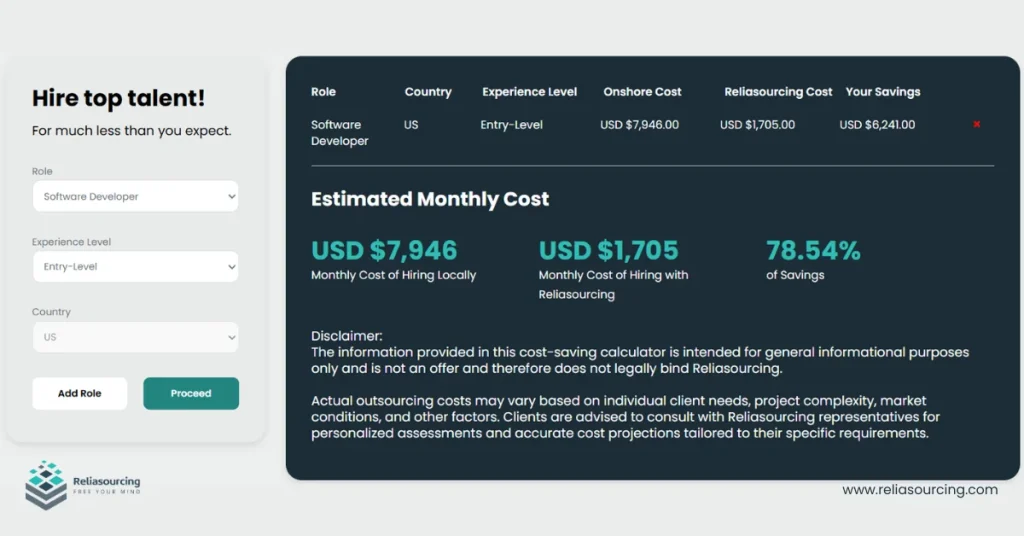
Outsourcing with Reliasourcing grants you more than 70% in cost savings when outsourcing software developers compared to onshore costs. Use our cost savings calculator to estimate your potential savings and start building your ideal development team.
Best Practices for Successful Outsourcing
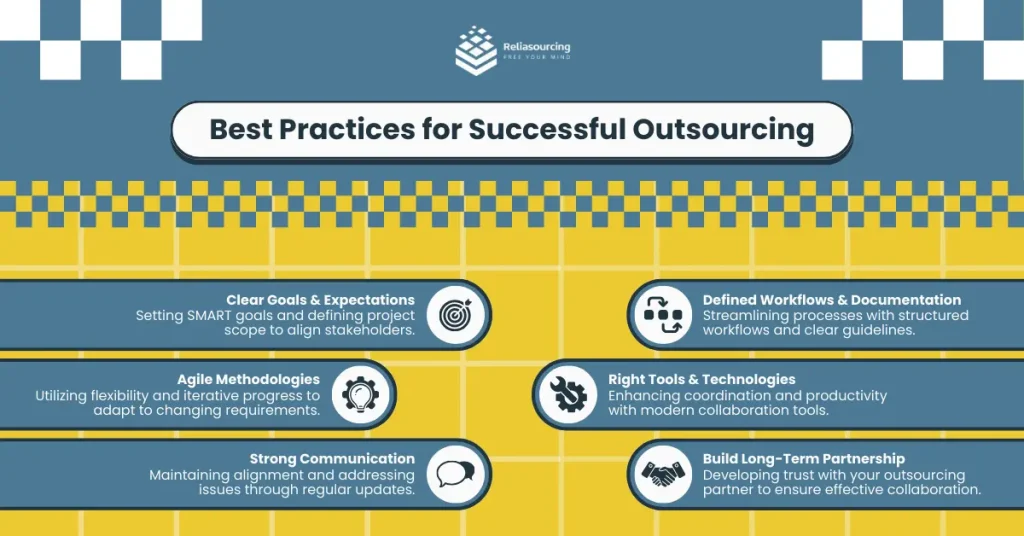
Set clear goals & expectations
Define project scope, milestones, and key deliverables. Clearly outlining expectations helps prevent misunderstandings and ensures that all stakeholders are aligned. Setting SMART (Specific, Measurable, Achievable, Relevant, Time-bound) goals can make a huge difference in maintaining efficiency and tracking progress. Understanding why outsourcing is a strategic choice for many companies can also help you determine how it aligns with your own business model.
Use agile methodologies
Agile development allows for flexibility and iterative progress to ensure projects adapt to changing requirements. Businesses can avoid costly missteps by breaking work into sprints and continuously reviewing progress to foster a culture of collaboration and responsiveness, making it easier to provide feedback and implement improvements.
Foster strong communication
Consistent communication is the backbone of successful outsourcing. Regular updates via Slack, Jira, or project management tools help keep teams aligned and ensure that issues are addressed promptly. Holding frequent video calls and status meetings also provides better visibility into project progress and fosters stronger relationships between remote teams.
Use defined workflows & documentation
Establishing structured workflows helps streamline the development process. Clear documentation, including coding guidelines, style guides, and process maps, ensures that outsourced teams follow best practices. A well-organized knowledge base similarly helps new team members onboard quickly and contribute efficiently.
Leverage the right tools & technologies
Modern collaboration tools like Trello, Asana, GitHub, and Zoom enhance project coordination and task management, especially when collaborating with remote team members. Automated workflows, real-time reporting, and AI-powered analytics also improve decision-making and optimize productivity across distributed teams.
Build a long-term partnership
Developing trust with your outsourcing partner fosters long-term success since a strong partnership ensures smoother workflows, increased productivity, and more effective collaboration. Rather than viewing outsourcing as a short-term cost-cutting strategy, businesses should invest in a sustainable relationship that fosters innovation and mutual growth.
Software Development Outsourcing vs. In-House Development
Choosing between outsourcing software development and using an in-house team is a key decision for businesses. Outsourcing can reduce costs and provide access to diverse talent, allowing for scalability and enabling internal teams to focus on core tasks. However, it also poses risks like less control, communication barriers, and security issues. Meanwhile, in-house teams offer control and collaboration, ensuring data security and tailored workflows, but come with higher costs, a limited talent pool, and slower scaling.
By weighing these factors, businesses determine whether outsourcing or in-house development aligns better with their operational goals and resource availability. Below is a table taking into account factors to consider when choosing between the two:
| Factor | Outsourcing | In-House Development |
| Cost | Lower | Higher |
| Talent Pool | Global | Limited |
| Scalability | High | Fixed Capacity |
| Control Over Process | Moderate | Full Control |
| Time-to-Market | Faster | Longer Development |
Frequently Asked Questions
What is the best country for outsourcing software development?
The best country for outsourcing software development depends on cost, talent pool, time zone alignment, and language proficiency. Countries like the Philippines, India, and Eastern European nations such as Ukraine and Poland are among the top choices. The Philippines, in particular, is known for its strong English proficiency and cost-effective labor market, making it an ideal destination for businesses looking for affordable yet high-quality outsourcing services.
How do I ensure quality when outsourcing software development?
To ensure quality when outsourcing software development, businesses must take a structured approach. The first step is to thoroughly vet potential vendors by assessing their past projects, client reviews, and technical expertise. Defining project requirements, milestones, and quality standards from the outset helps maintain accountability.
When working with offshore teams, it’s crucial to establish clear communication channels to bridge any potential gaps in expectations. Integrate regular progress reviews and testing phases into the workflow to identify issues early. Moreover, effective collaboration tools like Jira, Trello, and GitHub ensure transparency and alignment throughout development.
What are the most common mistakes in software outsourcing?
The most common mistakes in software outsourcing include selecting a vendor based solely on cost, failing to establish clear communication channels, and neglecting intellectual property protection. Businesses prioritizing the lowest price over quality often experience delays, subpar outcomes, and higher long-term costs due to rework. Poor communication—caused by time zone differences, cultural misunderstandings, or lack of structured reporting—can likewise lead to misalignment between client expectations and final deliverables. Additionally, businesses that fail to set clear quality benchmarks and milestones may struggle with inconsistent results.
Some key software outsourcing mistakes to avoid include:
- Lack of legal protections. Without well-defined NDAs, IP ownership clauses, and compliance checks, sensitive business data may be at risk. Vendors without strong cybersecurity policies also expose businesses to security breaches.
- Unclear project scope and expectations. Failing to define precise project requirements and KPIs can result in frequent scope changes, misaligned deliverables, and extended timelines.
- Ineffective collaboration and onboarding. Outsourced teams may struggle to integrate into existing processes without structured onboarding and transparent workflows, leading to inefficiencies.
How do I protect my intellectual property when outsourcing?
Protecting intellectual property when outsourcing software development requires proactive legal and security measures. Businesses should implement NDAs and well-defined contracts that specify code ownership, confidentiality terms, and data protection policies. Selecting vendors with internationally recognized security certifications such as ISO 27001 or GDPR compliance adds an extra layer of protection. Encrypted storage options and access control measures effectively protect proprietary information from unauthorized access.
How do I calculate the ROI of outsourcing software development?
Calculating the ROI of outsourcing software development involves analyzing the cost savings and efficiency gains achieved through outsourcing. Businesses should compare the total outsourcing cost—including vendor fees, management overhead, and integration expenses—with benefits such as reduced time-to-market, enhanced software quality, and increased scalability. Tracking key performance indicators (KPIs) such as project completion time and customer satisfaction scores can provide a clearer picture of outsourcing success, and a well-executed outsourcing strategy should lead to higher efficiency and improved overall business performance.
How Reliasourcing Helps with Software Development Outsourcing
Reliasourcing provides tailored software outsourcing solutions designed to meet your unique business needs. Our approach combines vetted talent with AI-powered processes, ensuring you receive high-quality development support for full-cycle projects or specific tasks.
The key advantages of working with Reliasourcing include our dedicated teams that seamlessly integrate with your in-house staff and our commitment to quality assurance, which are paired with efficient project management tools. We at Reliasourcing prioritize effective communication and agile methods to keep your projects on track and within budget.
Ready to get started on your development team and maximize efficiency? Connect with Reliasourcing today to explore how our customized solutions can drive your business forward.
The Bottom Line: Software Development Outsourcing
Outsourcing software development offers businesses an opportunity to cut costs, access specialized talent, and accelerate product development. Choosing the right outsourcing partner ensures success, so with the right vendor, companies can optimize workflows and gain a competitive edge while focusing on core business operations and leaving the software development to experts.
Key Takeaways
- Outsourcing allows businesses to reduce operational costs while accessing a global talent pool.
- Choosing the right outsourcing model—onshore, nearshore, or offshore—depends on budget, expertise requirements, and collaboration needs.
- Proper vendor selection, clear communication, and robust security measures are essential for successful outsourcing partnerships.
- Businesses should balance cost savings with quality assurance for long-term growth and scalability.
Next Steps for Businesses Considering Outsourcing
- Assess your needs. Identify which development tasks or projects can benefit the most from outsourcing.
- Research potential vendors. Evaluate outsourcing firms based on expertise, industry reputation, and client success stories.
- Define clear goals and expectations. Establish project milestones, performance metrics, and communication protocols.
- Start with a pilot project. Test the outsourcing partner’s capabilities with a small project before committing to a long-term engagement.
- Ensure legal and security compliance. Protect intellectual property with strong legal agreements and ensure data security compliance.
Outsourcing software development holds great promise for enhancing business operations. And it begins with clearly defining project goals, conducting thorough research for reliable partners, and maintaining open communication to maximize its benefits. Leveraging diverse perspectives and skills from around the world can result in a dynamic environment where fresh ideas flourish, and the possibilities for success become limitless.

